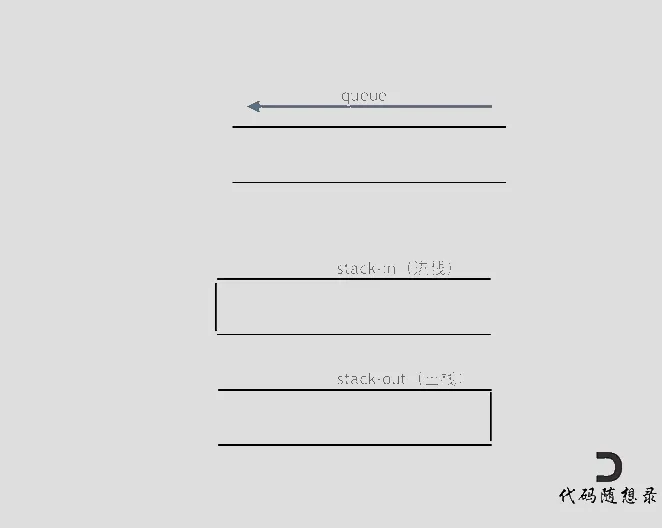Table of Contents
[toc]
232. 用栈实现队列
简单
请你仅使用两个栈实现先入先出队列。队列应当支持一般队列支持的所有操作(
push、pop、peek、empty):实现
MyQueue类:
void push(int x)将元素 x 推到队列的末尾int pop()从队列的开头移除并返回元素int peek()返回队列开头的元素boolean empty()如果队列为空,返回true;否则,返回false说明:
你 只能 使用标准的栈操作 —— 也就是只有
push to top,peek/pop from top,size, 和is empty操作是合法的。你所使用的语言也许不支持栈。你可以使用 list 或者 deque(双端队列)来模拟一个栈,只要是标准的栈操作即可。
示例 1:
提示:
1 <= x <= 9最多调用
100次push、pop、peek和empty假设所有操作都是有效的 (例如,一个空的队列不会调用
pop或者peek操作)进阶:
- 你能否实现每个操作均摊时间复杂度为
O(1)的队列?换句话说,执行n个操作的总时间复杂度为O(n),即使其中一个操作可能花费较长时间。
用栈实现队列,需要一个输入栈,一个输出栈。
需要先用 Go 实现一个栈(这里使用 slice),然后再用该栈模拟队列。
原本需要在 stack.Len() 中加读锁,但在 LeetCode 中再多加一个读锁就会时间超限。。
下面动画模拟以下队列的执行过程:
执行语句: queue.push(1); queue.push(2); queue.pop(); 注意此时的输出栈的操作 queue.push(3); queue.push(4); queue.pop(); queue.pop();注意此时的输出栈的操作 queue.pop(); queue.empty();

push 数据,只要把数据放进输入栈即可。
pop 数据:如果输出栈为空,就把输入栈的数据全部导入输出栈,再从输出栈 Pop 数据。
fillStackOut: 将数据全部导入输出栈写成一个方法
peek 和 empty: 如果输出栈为空,就把输入栈的数据全部导入输出栈,再查看 stackOut 的栈顶元素、判断 stackOut 是否为空。
见详细代码:
// 用 slice 实现栈type myStack struct { Ints []int Lock sync.RWMutex}
func NewStack() *myStack { return &myStack{ Ints: []int{}, // 字面量 []int{} 已经分配好内存空间 }}
// Push 入栈func (s *myStack) Push(t int) { s.Lock.Lock() defer s.Lock.Unlock() s.Ints = append(s.Ints, t)}
// Pop 出栈func (s *myStack) Pop() int { s.Lock.Lock() defer s.Lock.Unlock() if s.Empty() { return 0 } val := s.Ints[s.Len()-1] s.Ints = s.Ints[:s.Len()-1] return val}
// Len 栈内存储的元素数量func (s *myStack) Len() int { return len(s.Ints)}
// Peek 查看栈顶元素func (s *myStack) Peek() int { if s.Empty() { return 0 } return s.Ints[s.Len()-1]}
// Empty 检查栈是否为空func (s *myStack) Empty() bool { return s.Len() == 0}
// ==========分割线==========
type MyQueue struct { stackIn *myStack stackOut *myStack}
func Constructor() MyQueue { return MyQueue { stackIn: NewStack(), stackOut: NewStack(), }}
func (q *MyQueue) Push(x int) { q.stackIn.Push(x)}
func (q *MyQueue) Pop() int { // 如果 q.stackOut 中没有元素,把 stackIn 元素全部 Push 到 stackOut 中 q.fillStackOut() // 如果 q.stackOut 中有元素则直接 Pop 元素 return q.stackOut.Pop()
}
func (q *MyQueue) Peek() int { q.fillStackOut() return q.stackOut.Peek()}
func (q *MyQueue) Empty() bool { q.fillStackOut() return q.stackOut.Empty()}
func (q *MyQueue) fillStackOut() { if q.stackOut.Empty() { for !q.stackIn.Empty() { val := q.stackIn.Pop() q.stackOut.Push(val) } }}
/** * Your MyQueue object will be instantiated and called as such: * obj := Constructor(); * obj.Push(x); * param_2 := obj.Pop(); * param_3 := obj.Peek(); * param_4 := obj.Empty(); */